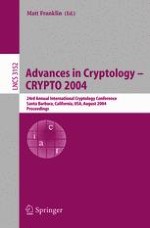2004 | OriginalPaper | Buchkapitel
Signed Binary Representations Revisited
verfasst von : Katsuyuki Okeya, Katja Schmidt-Samoa, Christian Spahn, Tsuyoshi Takagi
Erschienen in: Advances in Cryptology – CRYPTO 2004
Verlag: Springer Berlin Heidelberg
Enthalten in: Professional Book Archive
Aktivieren Sie unsere intelligente Suche, um passende Fachinhalte oder Patente zu finden.
Wählen Sie Textabschnitte aus um mit Künstlicher Intelligenz passenden Patente zu finden. powered by
Markieren Sie Textabschnitte, um KI-gestützt weitere passende Inhalte zu finden. powered by
The most common method for computing exponentiation of random elements in Abelian groups are sliding window schemes, which enhance the efficiency of the binary method at the expense of some precomputation. In groups where inversion is easy (e.g. elliptic curves), signed representations of the exponent are meaningful because they decrease the amount of required precomputation. The asymptotic best signed method is wNAF, because it minimizes the precomputation effort whilst the non-zero density is nearly optimal. Unfortunately, wNAF can be computed only from the least significant bit, i.e. right-to-left. However, in connection with memory constraint devices left-to-right recoding schemes are by far more valuable.In this paper we define the MOF (Mutual Opposite Form), a new canonical representation of signed binary strings, which can be computed in any order. Therefore we obtain the first left-to-right signed exponent-recoding scheme for general width w by applying the width w sliding window conversion on MOF left-to-right. Moreover, the analogue right-to-left conversion on MOF yields wNAF, which indicates that the new class is the natural left-to-right analogue to the useful wNAF. Indeed, the new class inherits the outstanding properties of wNAF, namely the required precomputation and the achieved non-zero density are exactly the same.
